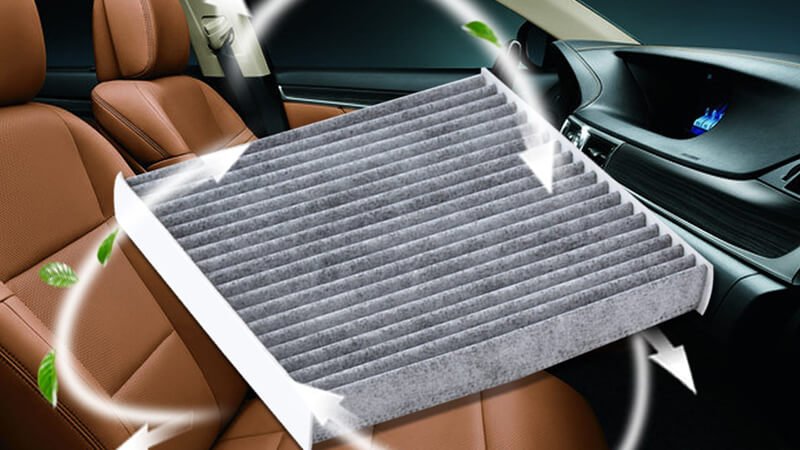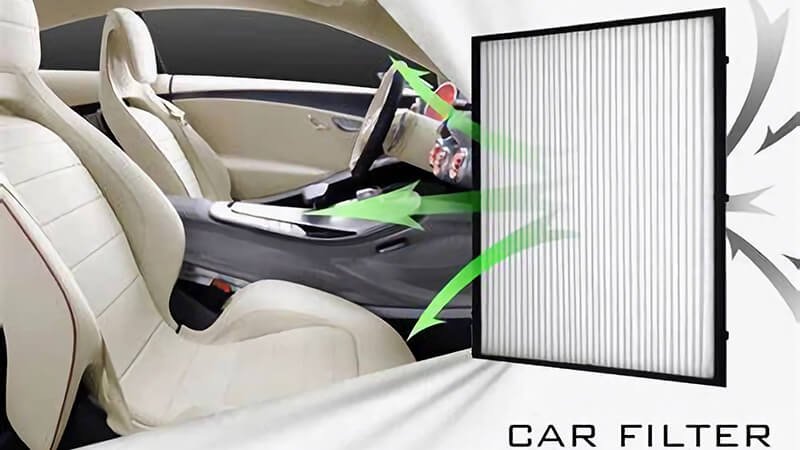I know the pain. Air smells odd. Windows fog fast. Fans get loud. Breathing feels hard. Allergy season makes it worse. I want clean air. I want a simple plan that works and does not waste money.
I keep the cabin air filter clean with light vacuuming, gentle checks, and on-time replacement. I avoid water on paper media. I choose a high-efficiency, low-restriction filter. I follow a simple schedule: inspect each service, replace at 12,000–15,000 miles, sooner in dust or pollen.
I write this with the lens of a supplier and a user. I build filters at Runex Auto. I also drive long routes in peak pollen. I want clean air and steady HVAC performance. I will show a clear method you can use today.

Can car cabin air filters be cleaned and reused?
You open the glove box. You pull the filter tray. You see dust, leaves, and pollen. You want to shake it clean and put it back. I get it. I also want to save time and cost. But I must protect air quality and the blower motor.
You can only do light cleaning on a cabin filter. You can tap out loose debris. You can use a low-power vacuum. You must not wash paper media with water. You should replace the filter on schedule. Runex Auto designs filters to keep airflow high until the service interval.
Dive deeper
What “cleaning” really means
Most cabin filters1 use pleated media. Many are paper-based or synthetic blends. They trap particles with depth loading. They hold dust inside the fiber structure. Light cleaning only removes surface debris. It does not remove embedded particles. If you wash paper media, you break the fiber bonds. The pores swell. The filter loses shape. Efficiency drops. Pressure drop can rise after it dries because fibers clump. So, I never wash a paper cabin filter. I also do not use compressed air close to the pleats. Strong air jets can tear the media or drive dust deeper.
What I allow between replacements
I allow two things. First, I tap the filter on a clean surface to shake out large debris. Second, I use a handheld vacuum at low power from the dirty side. I keep the nozzle a small distance away. I move slowly. I stop if the pleats flex too much. This gives a small improvement in airflow. It does not reset the filter to new.
How Runex Auto designs for steady airflow
Runex Auto2 cabin filters use high-loading media with a stable pleat geometry. We select fiber blends that keep low pressure drop as the filter loads. We add a rigid frame to prevent pleat collapse. Our carbon-layer option adds gas adsorption for odors while keeping airflow in check. We test pressure drop3 and efficiency across the service life in dusty and urban cycles. This way, the filter runs clean longer, and the HVAC fan does not strain.
| Topic | Do / Do Not | Why It Matters | Runex Auto Note |
|---|---|---|---|
| Water on paper media | Do not wash | Damages fibers, reduces efficiency | Our media is not made for washing |
| Light vacuum | Do with low power | Removes surface dust without tearing | Safe if gentle and not too close |
| Compressed air | Avoid or use very low pressure | Can tear pleats or embed dust deeper | Not recommended for paper pleats |
| Shake/tap cleaning | Do gently | Removes leaves and large particles | Helps a bit but not a reset |
| Replacement interval | Follow 12k–15k miles | Protects air quality and HVAC | Tested for stable airflow to interval |
I do light cleaning to buy time if I wait for parts. I still replace on time. My air stays clean. My fan stays quiet. My family breathes easier.

How often should a cabin air filter be cleaned?
You want a schedule that is simple. You do not want to over-service. You do not want to push too far and get odors or fogging. You want data and a clear line you can follow in every season.
I inspect the cabin filter at each oil change. I replace it every 12,000–15,000 miles, or once a year. I service sooner in high dust, heavy traffic, or pollen peaks. Runex Auto designs media to hold dust up to this window with low pressure drop.
Dive deeper
My simple interval rule
I like rules that I can remember. I set a base interval of 12,000–15,000 miles, or 12 months, whichever comes first. I mark the date and mileage on the filter frame with a pen. I also set reminders in my service app. If I drive in a city with heavy traffic, I lean toward 12,000. If I drive on clean highways, I push to 15,000.
When I shorten the interval
I shorten the cycle when I see any of these: strong pollen season, dusty roads4, wildfire smoke events, rideshare duty with high daily miles, or pet hair inside the cabin. I also shorten it if any symptoms show up: musty smell, reduced airflow at the same fan speed, frequent fogging, or more sneezing inside the car. I saw this with a fleet I support. Drivers had more respiratory complaints in spring. We moved to high-efficiency Runex Auto carbon filters5 and set a strict 12,000-mile change. Complaints dropped. HVAC cleanings also dropped, which saved labor.
How Runex Auto media holds steady longer
Our cabin filters use a multi-layer gradient6. The top layer catches larger dust. The middle layer traps fine particles. The carbon layer controls odors. This design spreads the dust load across depth. Air keeps flowing with less rise in pressure drop. We test per industry methods for dust loading and airflow. We then match the result to the service interval. The result is a filter that stays efficient and does not choke the blower early.
| Driving Condition | Inspect When | Replace When | Runex Auto Advice |
|---|---|---|---|
| Normal mixed driving | Each oil change | 12k–15k miles or 12 months | Use standard or carbon media |
| Heavy urban traffic | Each 5–7k miles | 10k–12k miles | Carbon layer helps with odors |
| Dusty/pollen season | Monthly in season | At start and end of season | Consider spare filter on hand |
| Fleet/ride-hailing | Monthly | 8k–12k miles | Track claims and HVAC amperage |
| Smoke/wildfire exposure | Immediate check | Replace after event | Protects lungs and avoids odor retention |
I keep the rule simple. I adjust for harsh conditions. I use filters that maintain flow as they load. This keeps my plan easy and safe.

Can I clean my air filter instead of buying a new one?
I want to save money. I want less waste. I want quick steps I can do in my driveway. I also do not want to harm my HVAC. I need a clear line between safe cleaning and risky hacks.
You can do basic cleaning to remove loose debris. You must not wash paper cabin filters. You must replace them on schedule. Runex Auto designs filters for easy DIY swaps. The tray access is simple. The frame is rigid. The pleats stay aligned during install.
Dive deeper
Safe DIY steps I follow
I gather a towel, a low-power vacuum, and gloves. I open the glove box and lower it per the manual. I slide the filter tray out. I note the airflow arrow. I take the filter out with two hands. I tap it gently on the towel to remove leaves and large dust. I vacuum from the dirty side at low power and keep the nozzle a bit away. I wipe the tray and the housing. I do not spray cleaners into the duct. I reinsert the filter with the arrow aligned. I close the glove box.
When replacement is the only right choice
If the filter is wet, warped, or has a strong odor that does not go away, I replace it7. If the pleats look dark and packed, I replace it. If the fan still needs a higher speed than before, I replace it. If I reach the mileage limit, I replace it. I do not wait for the fan to strain.
How Runex Auto helps with DIY and value
Runex Auto cabins filters8 come with clear arrows and QR codes that link to a short video. The frame is strong, so pleats do not twist during install. The media has a dust pre-layer9 that sheds large debris at the surface. This makes light cleaning more effective between services. The gasket seals well even after a removal for inspection. This keeps unfiltered bypass low. We also offer carbon media for odor control10. It helps in cities and during pollen peaks. With these features, I can do quick checks and save time. But I still replace on schedule to protect air quality.
| Action | OK for Paper Cabin Filters | OK for Synthetic/Hybrid Media | Notes |
|---|---|---|---|
| Tap to remove debris | Yes | Yes | Do gently |
| Low-power vacuum | Yes | Yes | Keep nozzle away from pleats |
| Wash with water | No | Rarely (check label) | Paper loses structure |
| Strong compressed air | No | No | Can damage media |
| Replace on schedule | Yes | Yes | Best way to ensure steady performance |
I like saving money. I save by preventing HVAC issues. Timely replacement beats deep cleaning. It keeps the system safe and the air fresh.

Why is my air filter dirty after 2 weeks?
You changed the filter. Two weeks later, you check it. It looks dirty again. You think the part is bad. You worry the HVAC is weak. I have seen this many times. Many causes are normal. Some need attention.
It can get dirty fast due to pollen peaks, road dust, construction, or smoke. It can also load fast if the recirculation door sticks open, if there is leaf debris in the cowl, or if the old filter slot leaks. Runex Auto frames and gaskets reduce bypass and keep loading even.
Dive deeper
Normal fast-loading scenarios
In spring, air holds heavy pollen. Filters turn yellow or green fast. This can happen in a few days. During road works, fine dust hangs in the air. City traffic adds soot. All of this ends up in the pleats. A filter that looks dirty is doing its job. Appearance alone does not mean failure. I watch airflow and smell. If both are fine, I keep the filter until the interval. I saw this during a regional pollen spike. We had a fleet that pulled filters after two weeks and thought they failed. We tested pressure drop11. It was still within spec. We set expectations. We replaced at 12,000 miles, not every two weeks. It saved cost and time.
When fast loading points to a fixable issue
If airflow drops hard in days, I check the cowl area12 under the hood. Leaves, seeds, or a missing screen can let debris flood the duct. I clean the cowl drain. I check the recirculation flap. If it sticks or cycles wrong, unfiltered air patterns can change and pull more dust. I also check for gaps in the filter slot. A bent frame can allow bypass. Unfiltered air then dumps dust deeper, which makes the visible pleats look worse as they catch more near the edges.
How Runex Auto reduces false alarms
We design frames that keep a tight seal. Our gaskets are uniform. Our pleats are deep and evenly spaced. This spreads dust across the media. Pressure drop rises slowly. We provide guidance to check pressure drop and fan current if you have tools. If airflow is still good, a dirty look does not demand a change yet. We also offer a carbon layer13 that hides color change a bit, which reduces alarm even when dust is present. But color is not the measure. Performance is.
| Symptom | Likely Cause | What I Do First | Runex Auto14 Angle |
|---|---|---|---|
| Dirty look in 2 weeks | Pollen/dust spike | Check airflow and smell | Media designed for depth loading |
| Big airflow drop in days | Cowl debris or flap fault | Clean cowl, check recirc door | Seal helps, but upstream fix is key |
| Odor after short time | Moisture/organic load | Check for leaks, replace with carbon | Carbon layer improves odor control |
| Dust at edges of filter | Slot bypass or bent frame | Inspect slot, replace filter, reseat | Rigid frame reduces bending |
| Fogging despite new filter | Moisture in HVAC | Clean evaporator, check drain | Filter helps, system still needs service |
I do not panic when I see dust. I test airflow. I fix upstream issues. I rely on a filter with strong media use and a tight seal. This keeps air clean and cost low.

Conclusion
I keep my cabin air15 clean with simple steps. I inspect at each oil change. I do light vacuuming only. I replace every 12,000–15,000 miles, sooner in harsh seasons. I avoid water on paper media. I pick a high-efficiency Runex Auto filter with low pressure drop and a strong seal. I track airflow, not only color. This protects the HVAC and my health.
-
Explore this link to discover top-rated cabin filters that ensure clean air and optimal performance for your vehicle. ↩
-
Learn about Runex Auto's innovative designs that enhance airflow and filter longevity, ensuring a better driving experience. ↩
-
Understanding pressure drop is crucial for maintaining filter efficiency; this resource explains its impact on air quality. ↩
-
Find tips on vehicle maintenance specifically designed for dusty road conditions to ensure optimal performance. ↩
-
Explore the advantages of Runex Auto carbon filters for improved air quality and reduced respiratory complaints. ↩
-
Learn how multi-layer gradient filters enhance air filtration efficiency and prolong filter life. ↩
-
Learn the key signs that indicate it's time to replace your air filter to maintain optimal performance and air quality. ↩
-
Explore how Runex Auto cabins filters enhance your DIY maintenance with user-friendly features and effective air quality control. ↩
-
Discover how a dust pre-layer in air filters can improve cleaning efficiency and prolong filter life. ↩
-
Find out how carbon media effectively combats odors, especially in urban areas and during pollen seasons. ↩
-
Understanding pressure drop is crucial for maintaining filter efficiency and ensuring optimal airflow in your system. ↩
-
Cleaning the cowl area can significantly improve airflow and prevent debris from affecting your vehicle's performance. ↩
-
Learn about the benefits of carbon layers in filters and how they can enhance air quality by controlling odors. ↩
-
Explore how Runex Auto's innovative designs can enhance filter performance and reduce maintenance costs. ↩
-
Find the best cabin air filter from Runex Auto. ↩













